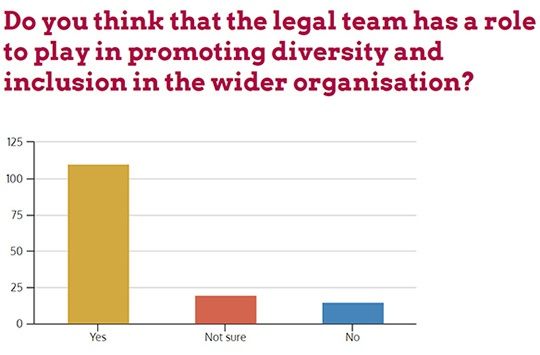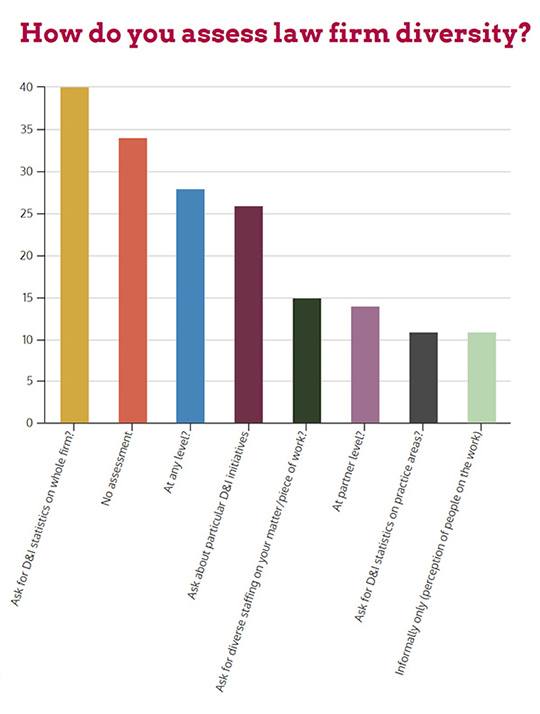In order to make the survey representative of the UK economy, we collected responses from a variety of job titles, a cross section of industries and a range of small and large companies. The vast majority of our respondents (62%) are legal professionals: with general counsel, legal counsel and director of legal being the most prevalent job titles. The non-legal respondents in our survey sample had a good understanding of both their own legal department and the external legal services market – with respondents typically working within the c-suite or human resources.
In-house diversity: strategies and challenges
As society is becoming increasingly aware of the need for diversity; companies seeking better results and an advantage over their competitors must have a workforce that reflects the progressive shift taking place in the wider market. Research has shown that diversity contributes to better corporate results, greater innovation, and increased profits, making companies with diverse teams and leadership better positioned to compete in the current market. It is not surprising, therefore, that an overwhelming majority of organisations in the UK have formulated diversity plans that draw upon an array of both proven and newly formulated strategies. To examine the success of both old and new approaches, we asked our participants how effective they thought specific strategies were for promoting diversity and inclusion within their companies.
Our respondents overwhelmingly saw leadership taking a role in championing diversity, and flexible working practices as the two strategies which produced the best outcomes. These two had the highest proportion of participants reporting great or high impact on the levels of diversity and inclusion within the organisation. In contrast, out respondents saw recruitment and promotion strategies – covering approaches including diversity talent recruitment, targeted talent spotting and leadership development, as well as the sponsorship or diversity programmes, and the use of physical and environmental accessibility, as the least effective. It is worth noting however that some of these strategies are quite progressive and may not have taken hold in many organisations yet.
What’s in the future?
To assess the wide reaching dimensions of diversity we asked our survey participants where they believe future challenges for diversity lie. Interestingly, the distribution of responses was similar across most categories, illustrating that the concept of diversity is not specific to one challenge or segment of society. Gender was the most prevalent area of focus for our respondents (21%), followed by social mobility (17%), ethnicity (15%), mental health issues (14%), disability (14%) and LGBTQA (8%). At just 2% of total responses, age was the most under-reported challenge, perhaps reflecting the fact that most companies are already highly diverse in that respect.
What can in-house legal teams do to encourage diversity?
It has long been believed that in-house lawyers are professionals who have an unrivalled view of the company that they work within. Is it possible to combine their position, their extensive understanding of the law, in addition to knowledge of personal conduct to assist in developing an inclusive corporate environment? The vast majority of our survey participants believe that their legal team has a vital role to play in promoting diversity and inclusion. When asked to elaborate further, some thought that the legal department also has a guiding role in promoting diversity initiatives: ‘In the first instance, aside from HR, we are probably the department that best understands the subject legally so we’re in a great position to train and encourage understanding of this subject in others’.
Most of our respondents, however, felt that while legal has to contribute to diversity and inclusion actively, it does not have more of a role to play than other departments. Most of our survey participants responded negatively to the question ‘Are there specific initiatives that are unique to the legal department?’ This highlights the conviction of many professionals that while the legal department has to contribute to the diversity and inclusion vision of the company, these contributions should be within the framework of a broader corporate strategy.
Importance of diversity within law firms
It is becoming increasingly common when instructing law firms for companies to demand the same level of diversity that they encourage within their own companies: approximately 61% of our respondents believe that it is important to see a diverse team when instructing outside counsel. When asked about reasons for looking for diversity in law firms some respondents explained that they saw value in the variety of opinion and creativity that diversity brings.
One respondent stated that ‘social and age diversity can bring different viewpoints and mitigate the risk of “group think”’, while another professional said that ‘creativity is fed by diversity – people thinking differently and coming at a problem from a different perspective sharpens everyone’. On the other hand, some respondents felt that client knowledge, experience and competence are more important areas of focus when assessing law firms, with some even suggesting that too much focus on diversity may be counter- productive. One respondent opined: ‘It would create an artificial environment rather than the merit one needs from external teams. Selection should be “diversity blind” otherwise it will skew matters. Positive discrimination is never a great idea in my opinion’.
Finally, we asked our survey respondents to select the methods that they use to assess law firm diversity. The most commonly reported method was for clients to look for diversity and inclusion statistics of the whole firm, followed by inquiring about a particular diversity initiative. Less common methods were focusing on diversity and inclusion statistics on a specific practice area or specifically requesting diverse staffing on a particular matter or piece of work. Our respondents tended to focus primarily on diversity at any level rather than on partner level alone. Only 18% of our respondents did not assess law firm diversity.






